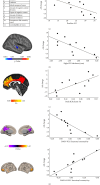Brain Structural and Functional Neuroimaging Features are Associated With Improved Auditory Hallucinations in Patients With Schizophrenia After Real-Time fMRI Neurofeedback
- PMID: 40236821
- PMCID: PMC11999755
- DOI: 10.1155/da/2848929
Brain Structural and Functional Neuroimaging Features are Associated With Improved Auditory Hallucinations in Patients With Schizophrenia After Real-Time fMRI Neurofeedback
Abstract
Auditory hallucinations (AHs) are debilitating and often treatment-resistant symptoms of schizophrenia (SZ). Real-time functional magnetic resonance imaging (fMRI) neurofeedback (NFB) is emerging as a flexible brain circuit-based tool for targeting AH via self-modulation of brain activity. A better understanding of what baseline characteristics predict NFB success will enhance its clinical utility. Previous work suggests that AH symptomology implicates measures across multiple modalities, including T1 structural MRI (sMRI), diffusion-weighted MRI (dMRI), and resting-state fMRI (rsfMRI). Specifically, AH severity and treatment response are associated with thinner superior temporal gyrus (STG), thinner dorsolateral prefrontal cortex (DLPFC), reduced white matter integrity in tracts connecting brain regions implicated in SZ symptomatology, increased within-default mode network (DMN) connectivity, and reduced DMN-DLPFC anticorrelation. In this study, we tested the individual and combined contributions of multimodal brain features for the prediction of AH change after NFB in adults (N = 25, 36.1 ± 10.0 years, 24% females) with SZ spectrum disorders (SZ or schizoaffective disorder) and frequent medication-resistant AH. Participants underwent a baseline MRI scan (including sMRI, dMRI, and rsfMRI) and were randomly assigned to receive NFB from their STG (n = 12, real condition) or NFB from their motor cortex (MC) (n = 13, sham condition). NFB success was operationalized as the improvement in AH severity after NFB. We found that higher baseline AH severity, greater STG thickness, decreased dorsal cingulum integrity, increased within-DMN resting-state functional connectivity, and increased DMN-DLPFC anticorrelation were each individually correlated with reduction in AH severity. However, in a combined regression model, DMN-DLPFC connectivity emerged as the only independent variable that explained the unique variance in AH change. These results suggest that a specific rsfMRI measure, namely DMN-DLPFC connectivity, may be a promising predictor of NFB success in reducing AH and support the precision medicine approach. Trial Registration: ClinicalTrials.gov identifier: NCT03504579.
Copyright © 2025 Jiahe Zhang et al. Depression and Anxiety published by John Wiley & Sons Ltd.
Conflict of interest statement
All authors declare that they have no actual or potential conflict of interest, including any financial, personal, or other relationships with other people or organizations within 3 years of beginning the work submitted that could inappropriately influence or be perceived to influence their work.
Figures


References
Publication types
MeSH terms
Associated data
Grants and funding
LinkOut - more resources
Full Text Sources
Medical

